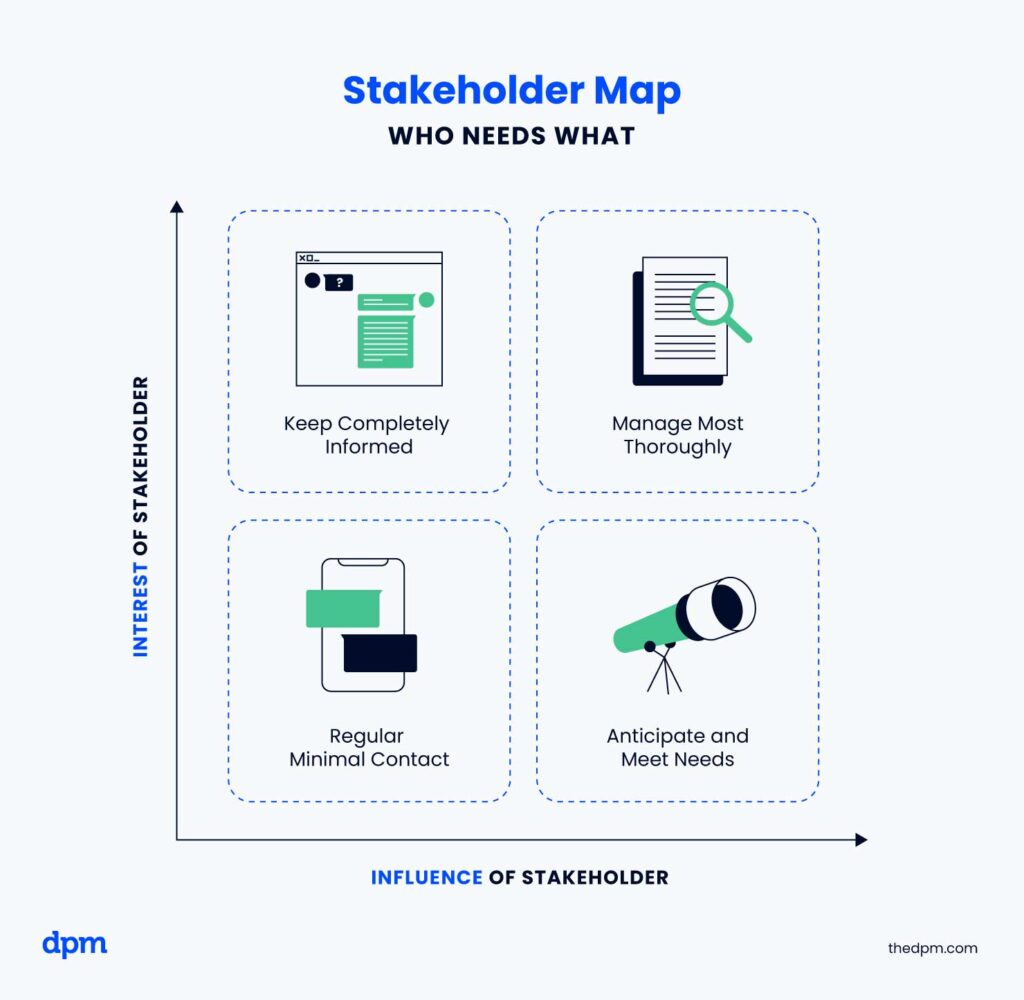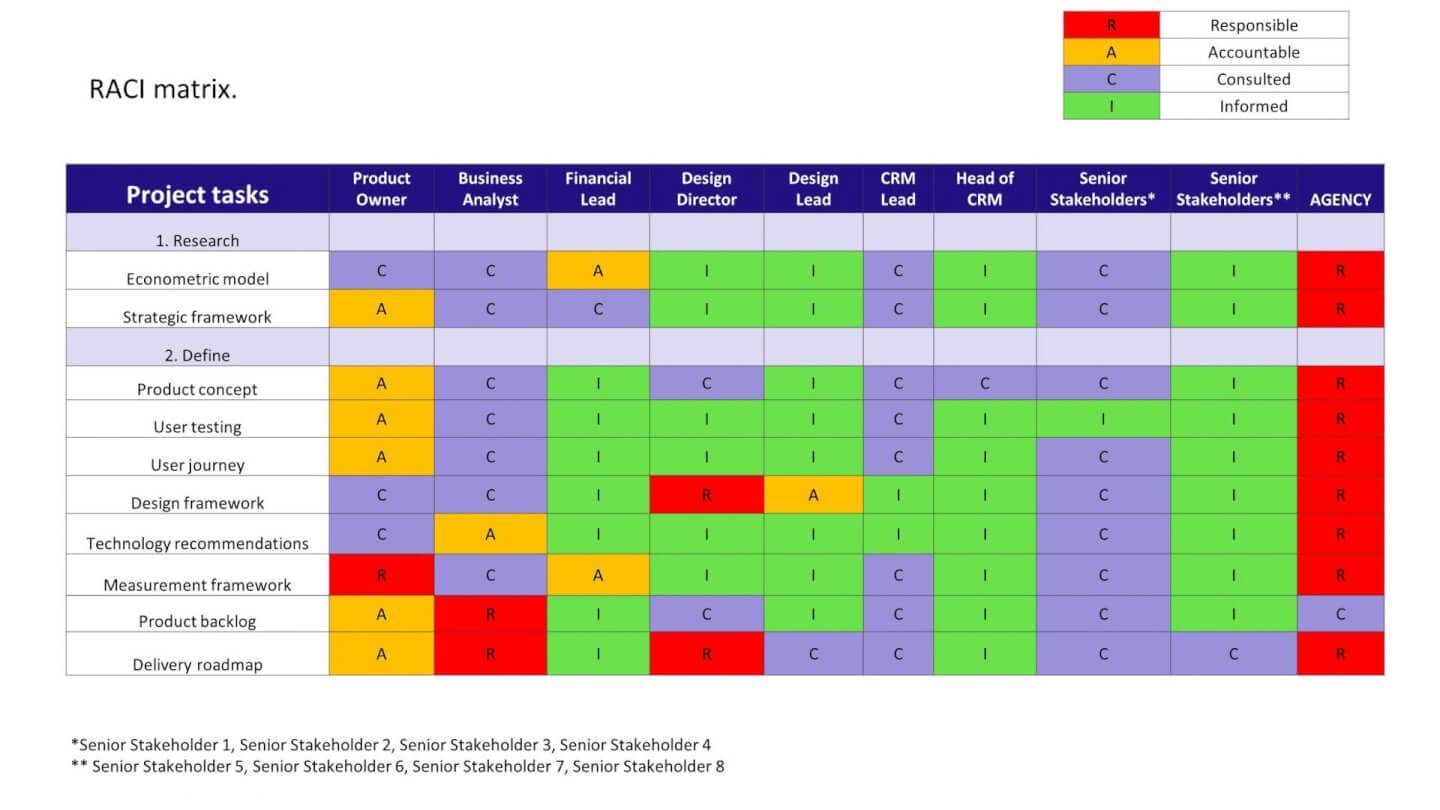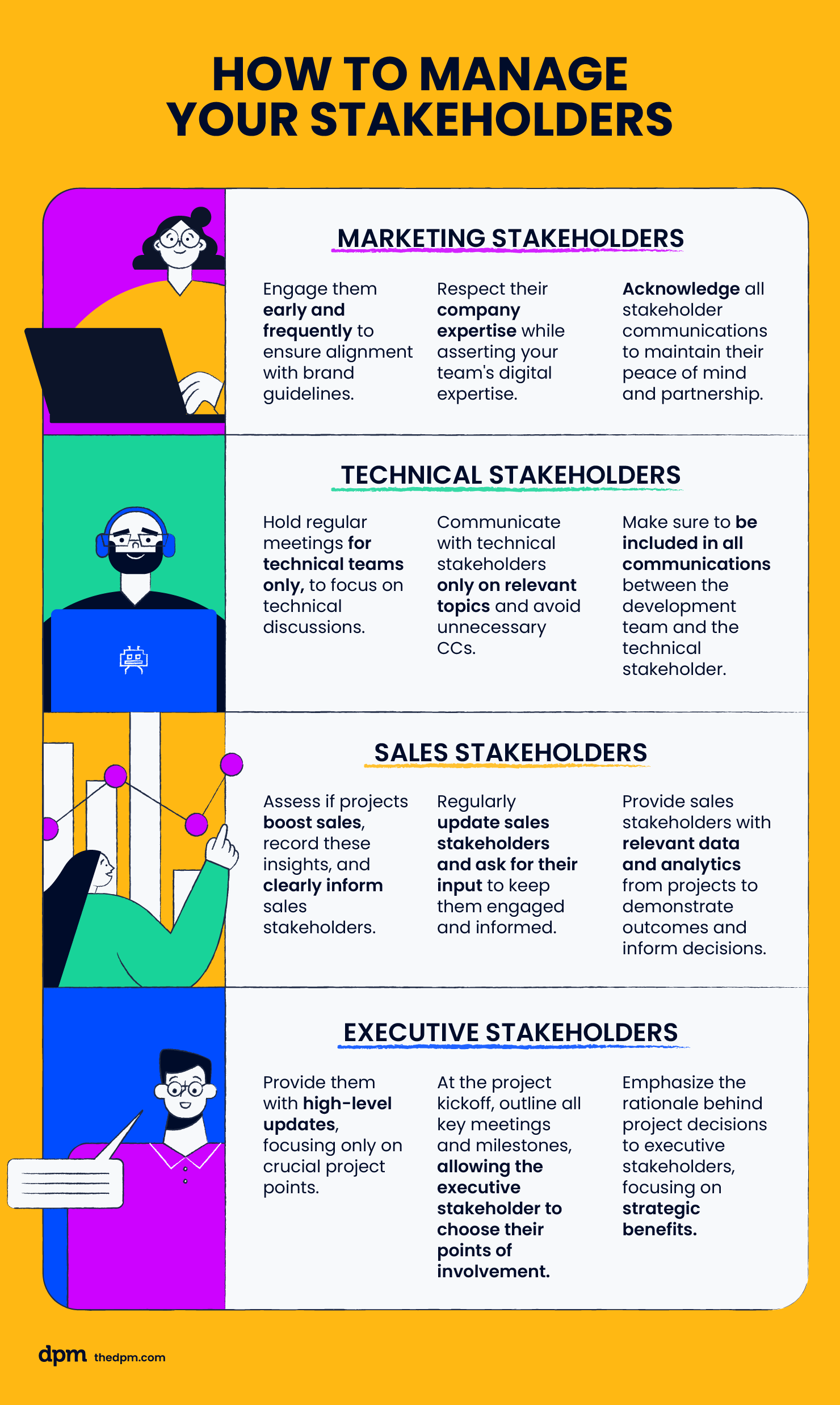Stakeholder management involves managing and maintaining relationships with all of the different people who have an interest in the outcome of your project, whether they are part of your org or outside it (such as a client).
Working with stakeholders (especially difficult ones) is not an easy task, but it is one that you can get a handle on with the right project stakeholder management process.
What Is Stakeholder Management?
Stakeholder management is the process of collaborating with stakeholders and maintaining stakeholder relationships and rapport. A stakeholder is either an individual, group, or organization who is impacted by the project outcome.
Stakeholders can include anyone from clients to project sponsors to suppliers to the CEO who's micromanaging your new website launch. You might have external stakeholders or internal stakeholders involved in your project.
6 Benefits Of Stakeholder Management
There are a variety of benefits to effective stakeholder management, when it's done properly. Much of this depends on the stakeholders themselves; unfortunately, some stakeholders are just difficult, no matter what you do.
- More clarity on who is responsible for what: By setting expectations and rules of engagement up front (especially by using a RACI chart), your stakeholders will have a better understanding of what they need to deliver and when. This includes things like feedback and website content.
- Smoother stakeholder communication: A proper stakeholder management plan will help you coach stakeholders on things like response times, what level of communication to expect, and how often they will hear from you.
- More deliverables completed on time: A stakeholder management plan will ensure that stakeholders know when items that they are responsible are due, so they won't hold up timelines (and if they do, they can't blame it on you).
- Less friction and stress: It can help ease the tension that comes from working with demanding or difficult stakeholders (although not entirely, in some cases).
- Faster decision making: You won't be waiting on key stakeholders as much for information or input into your decision-making process.
- Less project risk: You can expect fewer surprises and interruptions and a higher chance of project success, as key stakeholders will be conditioned to be more transparent and forthcoming.
Stakeholder Management Best Practices
Here are four best practices for managing stakeholders.
- Schedule regular check-ins. You're likely to have these scheduled already throughout the project life cycle to review status and progress (or as part of your stakeholder engagement plan), but build in some time to ask stakeholders how they are feeling about the level of communication and transparency on the project.
- Use project management software. Software tools can store documents like your RACI chart and stakeholder matrix, and can track project progress and status, which will speed up the process of creating status reports and ease the process of keeping stakeholders informed on project progress.
- Use collaboration software. These software tools are specifically built to allow project managers to keep in touch with their teams and project stakeholders, and they are especially useful when the team is working remotely.
- Send out a post-project survey. Use this to gather feedback from stakeholders on how communication and expectation management went, and to gauge their overall satisfaction with the project and the team.
How To Create A Stakeholder Management Plan
Here are five steps to create a stakeholder management plan:
- Create a stakeholder map
- Determine stakeholder needs and expectations
- Write a communication plan
- Make a RACI chart
- Monitor and adapt the plan
1. Create A Stakeholder Map
Create a list of everyone involved with or affected by your project, and hold a stakeholder mapping and stakeholder analysis session with your internal team. The outcome will be a stakeholder map—a grid that looks akin to a prioritization matrix, with level of interest on one axis and level of power (or level of influence) on the other axis.
Their level of power relates to the potential impact that they could have on the project, and their level of interest is related to how much they need to know.
- Stakeholders with high interest and high power or high influence must be managed most thoroughly. These are your most important stakeholders.
- Stakeholders with high interest but low power or low influence should be kept completely informed.
- Stakeholders with low interest but high power should have their needs anticipated and met.
- Stakeholders with low interest and low power should be provided with regular minimal contact.

2. Determine Stakeholder Needs and Expectations
Conduct interviews or surveys to understand what each stakeholder hopes to gain from the project and what they are expecting to get out of the project. It's important to determine expectations as early as you can, so you can set misaligned or out of sync expectations right. This will prevent challenges down the road stemming from the avoidable delta between expectations and the reality of the project.
Make sure all stakeholders are clear on what you'll be delivering (the statement of work will be helpful here) and what's in scope and out of scope, and get buy-in. This will help you avoid scope creep later.
3. Write A Communication Plan
Next, create a communication plan. A communication plan is a way to formalize a process for managing communication between your team and your stakeholders.
The communication plan should outline all stakeholders, titles, the frequency at which you will communicate with them, the channel of communication you’ll use, and any notes regarding preferences specific to each stakeholder.
4. Make A RACI Chart
Next, I suggest you and your internal project team make a RACI chart. This chart allows you and your team to define who is responsible for, accountable for, consulted about, and informed about the project deliverables, milestones, assets, etc. This RACI chart will include both client stakeholders and internal stakeholders, alike.

5. Monitor and Adapt the Plan
Throughout the plan, refer back to your stakeholder management plan and adjust it as needed according to stakeholder feedback and project progress. Your stakeholder's priorities might change, or you might get a request to provide updates to certain stakeholders more often or less often.
Occasionally, a stakeholder might leave a project, or you might identify a new stakeholder that you didn't know about at the beginning of the project. Your stakeholder management plan should be updated to reflect these types of changes as well.
Understanding The Needs of Your Stakeholders
Depending on the size of the company or organization, your project may have several stakeholders involved. There are different types of stakeholders within our digital industry that may be categorized as follows:

1. Marketing Stakeholders
If you’re working on a website or web platform, it’s likely one of your stakeholders will be someone from marketing or communications. If you’re working on SEO or an ad campaign, you will definitely collaborate with a marketing stakeholder.
How they are valuable:
- Their job is to understand the company, its brand, and its audience, each of which is invaluable to a successful project. Consider them your SME (subject matter expert) for their company.
- They may provide the company’s brand guidelines or assets, or put you in touch with creative resources. They will fuel persona definition (audience, user stories, etc).
- They will be an (if not the) approval point for marketing, communications, and digital strategy for your project.
How To Manage Marketing Stakeholders
- Start stakeholder engagement early and often. Don't make progress without involving a marketing stakeholder to weigh in on the marketing aspects of the project. You want to stay within the company’s brand guidelines and build trust in you, your project team, and your company.
- Allow them enough freedom to guide decisions, but know when to recommend best practices. They are the expert of their company; you and your project team members are the experts of the digital implementation.
- Make sure they feel heard and acknowledge everything. While you may not agree with every request or revision from your stakeholder, the very least you must do is acknowledge their message, route it appropriately, and follow up with them to close the loop. Otherwise, your marketing stakeholder will lose their peace of mind and sense of partnership.
2. Technical Stakeholders
Where a client has technology, they usually have a head of technology—that could be an internal technical director or an external technical consultant. In smaller organizations, this may be an in-house developer or IT assistant.
How they are valuable:
- Data can be messy and there is nothing worse than working with data with which you are unfamiliar. If you have a technical stakeholder, they will be able to support you and your team in cleaning up data and databases.
- They have context. It’s likely your technical stakeholder was there for the last project, and the one before that, and maybe even the one before that. They have seen what works and what doesn’t.
- They are able to speak a technical language that no other stakeholder type usually can. Your development team will appreciate that.
How To Manage Technical Stakeholders
- Schedule a regular touch base with just the technical teams. Rather than sit by and watch tension grow as both technical and non-technical folks discuss potential solutions, set aside time specifically for the technical teams to sit down and do what they do best: talk tech.
- Only cc the technical stakeholder for anything technical and development related. This includes technical documentation, technical requirements, hosting, security, and data. Unless they specifically request, do not feel obligated to copy them on all project communications.
- If/when your development team reaches out to the stakeholder for information, make sure you are included on all communications, and vice versa. Request that you be included on communications the stakeholder may have for your team—even if you yourself don't weigh in. It’s important to verify that technical conversations remain within scope.
3. Sales Stakeholders
You may find a sales stakeholder in the form of a sales director or sales & marketing manager who can speak to or sign off on elements of the project related to sales goals.
How they are valuable:
- Sales stakeholders have information on their company's sales goals. While they probably won’t let you see too much detail, they can provide enough information to give you and your project team fuel for how to best set up digital strategic objectives for the project.
- Your sales stakeholder is probably close to any C-level or executive stakeholders. If your project does not, prove to have some benefit to their sales numbers, they will communicate accordingly. However, if it does have some benefit, they are more likely to champion budget for future work.
- Sales stakeholders are usually out “in the field” more often than anyone else in their company. They can bring value in the form of relevant and timely happenings in the market and with their company’s audience.
How To Manage Sales Stakeholders:
- When engaging stakeholders from sales, keep the question “Will this drive sales?” in mind. It’s easy to focus on best practice for what you’re used to implementing and forget the goal specific to your client. If you’re working with a client with a sales force, ask yourself if what you’re implementing will drive sales for them, document it, and communicate this to them clearly.
- Reach out regularly to prompt their input. It’s common for sales stakeholders to not involve themselves unless prompted. Reach out every other week to provide status updates and ask if there is anything they have seen or experienced since you last talked that is worth discussing.
- Feed them data. While you may not consider your stakeholder a data analyst, understand that data will speak volumes to them. If you have launched a project for the client, have analytics or reporting implemented on the platform so you’re able to show this data to your sales stakeholder.
4. Executive Stakeholders
Your executive stakeholders are typically at the director level or above. This stakeholder will ultimately determine your project budget. If your point person is not the executive stakeholder, they probably report to the executive stakeholder.
How they are valuable:
- Either they are funding your project or they report to the person funding your project.
- Typically, what they say goes. Period.
- If you can tell a story about your project and its benefit to this stakeholder and they agree, there is potential for a long-term partnership between your company and theirs.
How To Manage Executive Stakeholders
- Keep your updates at a 10,000-foot view. Unless the executive stakeholder specifically requests more detail about a specific part of the project, include only the most important points in your updates. Vet what counts as important with your main contact before making your own assumptions.
- At the project kickoff meeting, present all of the deliverable review meetings, formal sign offs, milestones, and presentation meetings to the stakeholder and have them indicate where they are interested in being involved. Your client point person will let you know if you should include the executive stakeholder in any meetings beyond the ones they indicate.
- Understand and communicate the why behind your project to the stakeholder. Your executive stakeholder does not need to know the technical details or be walked through analytics. They want to hear the why behind the implementation: Why is this going to work? Why is this best for the company?
What's Next?
Looking for more tips for stakeholder management? Join the conversation in Slack with 100's of other digital project managers with DPM Membership! You'll also get access to 100+ templates for key project documents like project plans, statements of work, and communication plans.


